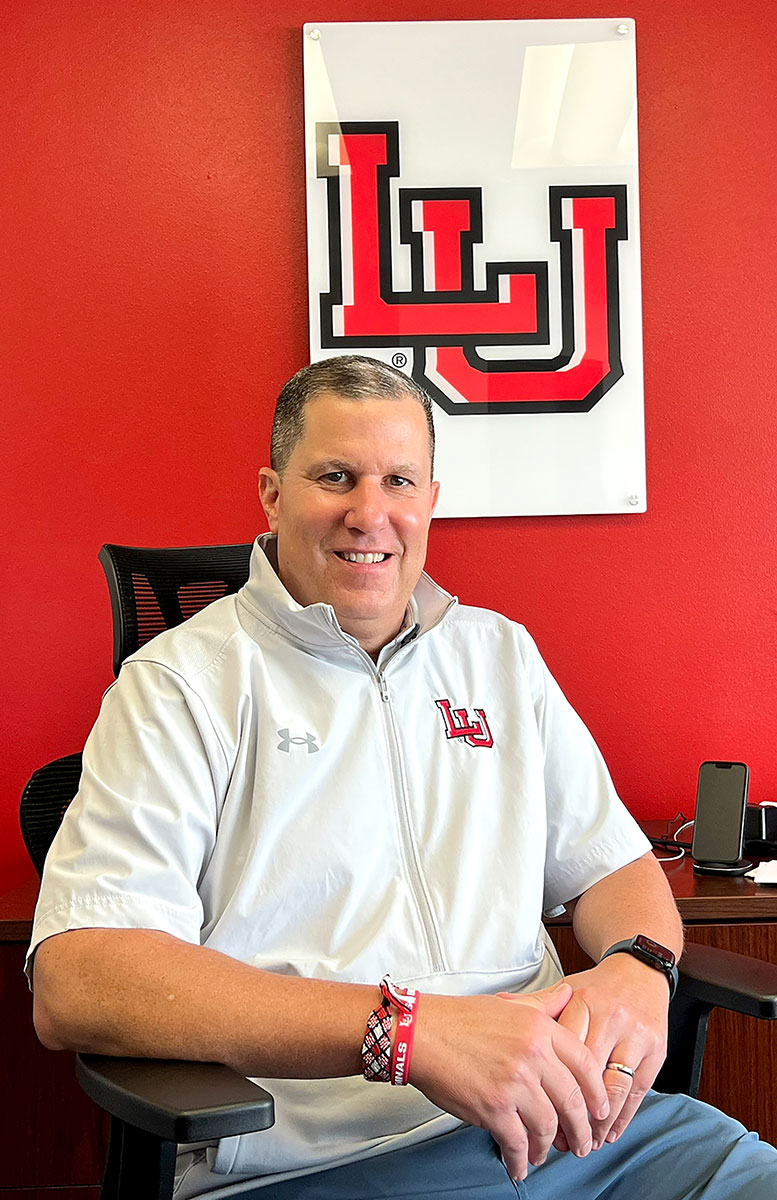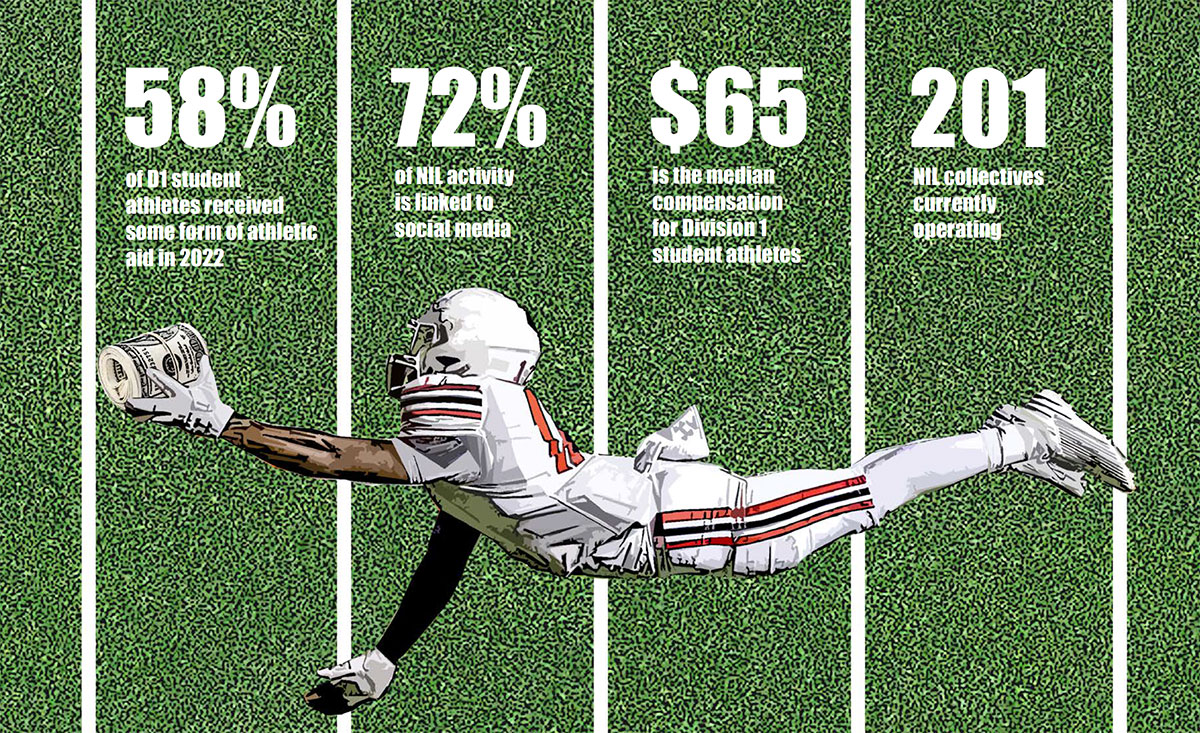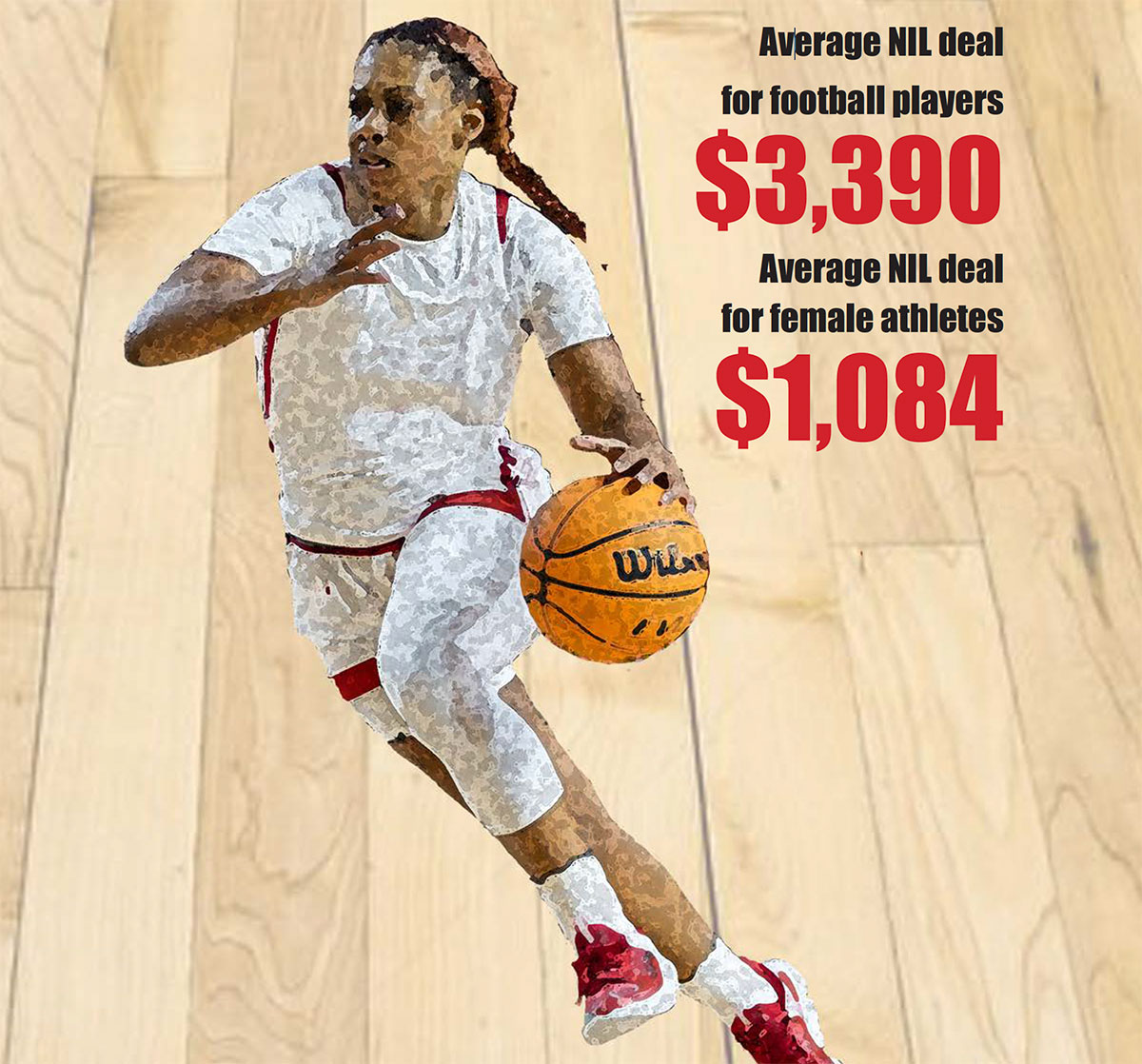NIL deals create uncertain scholastic athletic landscape
In a not-so dry and dusty college town, two young men walk into a bar. Both are decked head to toe in the traditional garb of an American pastime, but instead of cowboy hats, chaps and spurs, they sport helmets, shoulder pads and cleats.
This town isn’t big enough for the two of them, though. One becomes a hired gunslinger and takes a fifty-thousand dollar paycheck along with the starting quarterback job. Meanwhile, the other is forced to wander with the tumbleweeds until he finds a new home.
The days of the real-life old West may have come and gone, but college athletics is only just entering its own age of lawlessness. Either adapt, or get left behind in the dust — welcome to the Wild, Wild West of the name, image and likeness era.
The “Name, Image, Likeness” landscape is convoluted, confusing and rapidly changing. Thus, a primer chock-full of background knowledge is helpful before stepping through the doors into this metaphorical saloon.

Lamar University athletic director Jeff O’Malley.
UPbeat photo by Keagan Smith.
To fully understand the impact of NIL, one must go back to the very beginning of organized, unified college athletics. The National Collegiate Athletics Association was created in 1906 to “regulate the rules of college sport and protect young athletes,” according to the NCAA’s website.
Over time, the NCAA and the scope of its oversight grew exponentially. Before long, they’d established all-encompassing guidelines related to scholarships, academic performance, the rulebooks of the sports they governed, and just about anything else remotely related to college athletics.
Over decades, countless regulations were added to the student-athlete handbook, but one golden rule was traditionally stressed above the rest.
Under no circumstances were players allowed to receive any kind of compensation for playing a college sport. Cash payments or gifts of any kind were strictly off-limits, meaning scholarships and love of the game were the only real incentives to pursuing a playing career at the collegiate level.
Bear in mind that these young adult athletes sink countless hours into their respective crafts. They spend time in workouts, practices, and team meetings. Long bus rides and flights often make up multiple travel days on road trips, and that’s all outside of the two or three hours spent actually playing in NCAA-regulated contests. It’s like having a full-time job.
However, there is still a “student” in “student-athlete.” Each player is expected to take classes, do homework and maintain eligible academic standing just like any other college attendee. The result is that these young people are caught in a constant balancing act, simultaneously juggling athletic responsibilities alongside their studies.
Their dedication is certainly admirable. The plight of a college athlete isn’t an easy one, which is why it would make sense for players to be fairly compensated in addition to scholarships for the hours of effort they put in. The NCAA didn’t budge on their stance for years, but in June 2021, the dam finally burst regarding athlete compensation.
Following the United States Supreme Court’s unanimous 9-0 decision in NCAA v. Alston, student-athletes could now profit off the use of their name, image and likeness so long as they didn’t take money directly from the university. Suddenly, the NCAA went from being an all-powerful ruler of college athletics to a slightly-less omnipotent version of itself just trying to keep up with the times.
In the immediate hours after the landmark ruling, the first NIL deals began to trickle in. College basketball’s now-notorious twins, Haley and Hanna Cavinder, posed for Instagram with a jug of protein powder in one hand and a single dollar bill in the other after signing deals with Six Star Pro Nutrition. Jackson State football player Antwan Owens inked a deal with 3 Kings Grooming, a Black-owned hair care business.
Now, fast-forward to 2023. Heisman-winning USC quarterback Caleb Williams has an estimated NIL value of over $3 million thanks to sponsorships with Fanatics, AT&T and more. LSU and Olympic gymnast Livvy Dunne’s deals with ESPN, Body Armor and others add up to a similar mark of over $3 million. USC’s Bronny James, Colorado’s Shedeur Sanders and Texas’ Arch Manning are all related to superstar professional athletes, but multi-million NIL valuations are another shared commonality.
There are two certainties of the NIL era — student-athletes are deservedly raking in the dollars, while the landscape and mechanics which shape these deals are rapidly changing by the minute.
Take it from Lamar University athletic director Jeff O’Malley, who boasts more than 25 years of work experience in college athletics at Dayton, Massachusetts, Marshall, and now LU. If anyone is familiar with the NCAA, it’s him.
“I know the athletes were excited about NIL,” O’Malley said. “They have a chance to earn some money, which is something that was overdue. They should have the right to do that. It’s been a while since this happened two years ago, but there’s still a lot of questions now as to what it’s going to look like moving forward. It’s an ever-changing environment, almost daily.”
The main question O’Malley heard among peers was what guidance, or lack thereof, would shape the outlook of NIL.

When the Supreme Court decision was issued, Pandora’s box was opened and thrust college athletics into truly uncharted territory. The NCAA introduced an interim NIL policy which, while quite broad, provided the groundwork for student-athletes to sign deals.
The interim policy essentially stated that individuals could engage in NIL activities so long as they were agreements with a third party outside the university, consistent with state laws, and reported to the athlete’s school. Over time, additions to the policy were adopted, allowing universities to partner with outside service providers to create an NIL marketplace which connects athletes to potential sponsors. These are the most basic guidelines in place, but otherwise, rules and regulations surrounding NIL come primarily through state laws.
However, not every state has NIL laws in place, and those that do may have major discrepancies when compared with others. Since legislation varies from state-to-state and there’s no current NIL law at the federal level, the resulting landscape remains disjointed at best and outright unregulated at worst — thus, the Wild West analogy.
“The law here in Texas is really liberal in terms of what schools are able to do,” O’Malley said. “It conflicts with the NCAA directives a bit, and some of the other state laws aren’t quite as liberal as ours, while other states don’t even have laws. I think there’s a hope that someone recognizes they’re going to have to intervene, somehow, some way. They’re having those discussions now as to what that’s going to look like.
“I do think that we need a uniform rule across the country. How we’re going to operate and where that comes from, whether it’s the NCAA, Congress, or the two working together, is still to be determined. I think that schools and coaches and administrators just need some direction. Give us a set of rules and let us know what they are, and then we can figure it out from there.”
Even with federal regulation potentially on the way, the current Wild West environment brings issues along with it. The emergence of NIL collectives is one area of concern. These collectives are essentially independent ventures funded primarily through wealthy alumni and other influential boosters.
There are around 200 collectives operating across the country, but they are much more common amongst the largest and most prominent universities. For instance, 92% of Power Five schools have an NIL collective. While an even playing field is desirable so that no school has an unfair advantage over others, that just isn’t the reality of how college athletics works.
Instead, the power lies with those who possess the deepest pockets. Financial compensation for player performance, or “pay for play,” may be strictly outlawed by the NCAA, but collectives providing NIL deals for student-athletes, and even incoming recruits, is technically allowed.
So, how can this pseudo-tampering in the recruitment or transfer process be mitigated to prevent prominent programs from gaining an unfair advantage? Nobody really knows.
“That’s kind of the age-old question,” O’Malley said. “It becomes more and more prevalent, asking, ‘What does our athletic program look like? What do the other FCS and Southland Conference athletic programs look like in the future?’ As we get talented freshmen to come in here and have a lot of success, they’re going to want to move on to other schools. So, is there a way to keep them, through these collectives and NIL from doing that? That’s something I think we can try to do eventually, but for now most are just asking, ‘Where do we fit in the pecking order of this new world of NIL and transfer portals?’”
On the individual level, there are still questions about how much money a student-athlete should be able to make, as well as how those NIL deals can be given out in a fair manner to players from a variety of both men’s and women’s sports.
During 2022, an estimated 17% of Division I student-athletes participated in NIL activities. NIL platform Opendorse estimated that during the second year of the NIL era, the total amount spent on these opportunities crossed the $1.1 billion mark — though that figure is inflated by the massive contracts major companies such as Adidas, Nike, Gatorade and other brands hand out to the NCAA’s megastars.
Opendorse’s data said the average payout of an NIL deal was somewhere in the range of $1,500-1,800. In reality, the vast majority of student-athletes make far less than that. The median NIL payout is somewhere closer to just $65.
The question of NIL equality between men’s and women’s sports is also worth asking. Football accounts for 55% of NIL deals, but even with the sport removed from the equation, Opendorse’s data estimated nearly 60% of NIL compensation goes to athletes in men’s sports.
Title IX prevents sex-based discrimination in college athletics. However, it governs only collegiate institutions themselves. Unfortunately, it has no effect on ensuring women’s sports get fair recognition and NIL opportunities.
Lamar’s women’s sports have been incredibly successful as of late. Lady Cardinal soccer won back-to-back Southland titles to go along with NCAA tournament appearances in both years. That level of achievement is more than deserving of NIL compensation.
“We want our women to get out there and get as many deals as they can,” O’Malley said. “Look at the gymnast at LSU killing it through TikTok and how much money she’s making. That proves that there’s opportunities. We just have to give our kids the best resources possible to take advantage of that.”
The first major NIL development at Lamar occurred in February 2023. LU athletics teamed up with INFLCR, an industry-leading service which provides an NIL platform to more than 3,500 teams nationwide. This partnership resulted in the creation of the CardiNIL exchange, which gives Lamar student-athletes a resource to pursue potential opportunities by connecting them with interested businesses and individuals. The exchange streamlines the payment and reporting processes, also tracking users’ social media engagement statistics.
A handful of Lamar student athletes in the football and baseball programs have inked NIL deals, and O’Malley said he expects that number to grow in the coming years as the community continues to learn about and engage with the exchange. He said a benefit of being in Beaumont is that Lamar is the main sports team representing the area, so there are more chances for student-athletes to get out in the community and grow the synergy between the city, its businesses and Cardinal athletics.

Additionally, O’Malley and his staff have stressed the importance of NIL and financial education to Lamar’s athletes. They have compliance meetings with players to make sure everyone is on the same page, and INFLCR provides information on taxes, contracts and more through the CardiNIL Exchange.
“We also hold financial planning and resource meetings with them,” O’Malley said. “We’ve had some outside people come in and talk to them about fiscal responsibility, what to do with money and how to save it. As adults, people kind of take that kind of stuff for granted, but you put yourself in the shoes of student athletes (with) newfound money, so we want to educate them on how best to act with it.”
As NIL discourse and regulations continue to evolve, the entire college athletics landscape will undoubtedly keep changing with it. It’s nearly impossible to predict where it will go from here.
Whether you believe NIL is good, bad, or ugly doesn’t matter — it’s inescapable.
